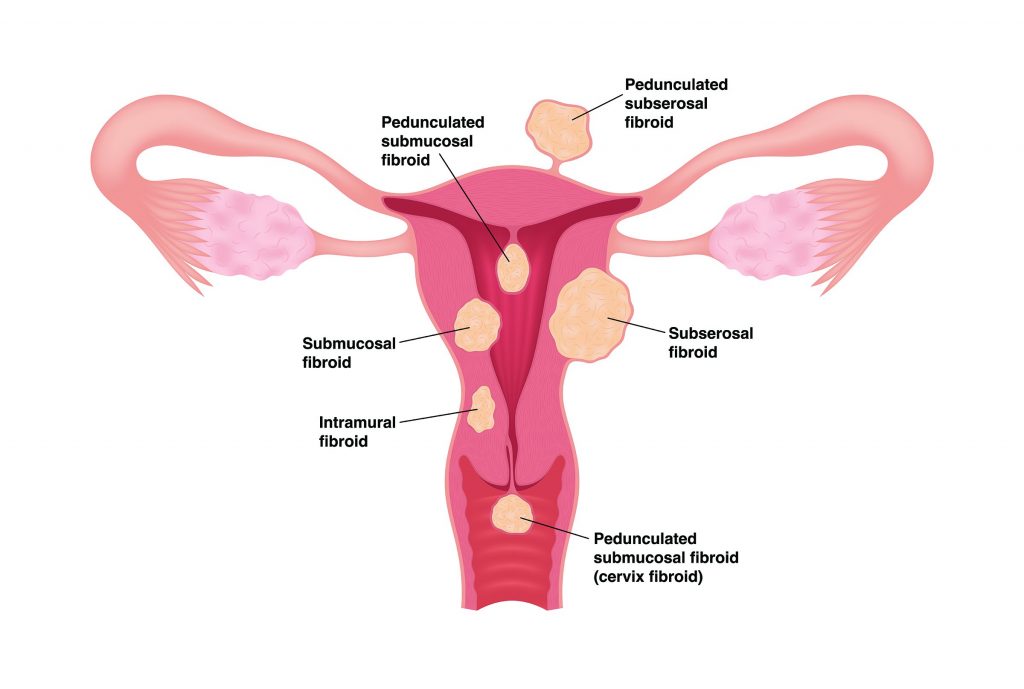Fibroid removal isn’t always something women feel the need to get done right away. In cases when women don’t have symptoms, only became aware of the issue during a routine pelvic exam, or the pain is manageable, they think, “I can live with this.” Watchful waiting is a viable option—but not for too long.
Uterine fibroids can get worse if they continue to grow. This fibroid growth is caused by several factors. The most significant of these growth factors are hormones. According to the Office on Women’s Health, estrogen and progesterone stimulate development of the uterine lining during each menstrual cycle in preparation for pregnancy.
Like any medical condition if left untreated, growing fibroids can increase your symptoms and keep you from your daily activities. In addition, the earlier you look into your options, the easier and more effective fibroid removal is without having the threat of life-altering consequences.
Remember that knowledge is empowerment: You do have options to take control of your own health.
What Size Fibroids Should Be Removed?
Researchers estimate that 70-80 percent of all women develop fibroids between 35 and 54. However, fibroids can occur in women younger than 35 and until menopause. These non-cancerous tumors develop from your uterus’ muscle tissue and tend not to stay the same size. They also multiply. This is why fibroid removal is so important. What was at first minor symptoms or no symptoms become increasingly painful as fibroids grow and either become twisted or begin to press against organs. The result is a varying number of painful symptoms that affect your quality of life and can lead to complications, including:
- Infertility
- Pregnancy complications, including miscarriages
- Anemia from heavy and irregular menstrual bleeding
- Urinary tract infections
So when it comes to fibroid removal, what size fibroids should be removed? Any size. And if possible, all of them. A key point to remember is that fibroids not only grow in size and numbers. They can grow:
- Inside the uterine walls (intramural fibroids)
- Just underneath the uterine lining (submucosal fibroids)
- Outside the uterus (subserosal fibroids), or
- On a long stalk inside or outside of the uterus (pedunculated fibroids)

The location and weight of these fibroids cause increasingly painful symptoms. For example, these range from heavy menstrual bleeding to pain during sex, back and leg pain, severe cramping, pelvic pain and pressure, and more.
What Are Common Fibroid Removal Procedures?
Usually your fibroid specialist in Dallas, TX or gynecologist can spot any abnormal changes in your uterus’ shape during a routine pelvic exam. They can also use your family history, symptoms, and ultrasound or MRI to find out for sure if you have fibroids. Once you have a diagnosis, your doctor may recommend one of the following:
- Uterine Fibroid Embolization (UFE) — UFE does not technically remove fibroids in the way surgery does. However, it is a minimally-invasive procedure that cuts off blood flow to all fibroids, causing them to shrink and die. UFE is low risk, no incision, faster than some of the other options and an alternative to surgery. Continue reading below for more details about UFE.
- Hysterectomy — A hysterectomy used to be the popular option for fibroid removal. It is still widely used today and is highly effective. However, it is also an invasive surgical procedure that many women prefer to avoid. With a hysterectomy, all or part of a women’s uterus is removed. In some cases, her fallopian tubes and ovaries are removed, too. It takes a longer time to heal from a hysterectomy, and your body will never be the same again.
- Myomectomy — Much like a hysterectomy, a myomectomy is also a surgical procedure that must be carefully considered. The goal is to remove uterine fibroids while preserving the uterus. It is the procedure of choice for women who want to get pregnant. However, it eliminates the ability to have a vaginal birth in the future. Most gynecologists insist on C-section after myomectomy. The size and location of the fibroids determine how this surgery is performed.
- Acessa — In the Acessa surgical procedure, a small probe is placed into a fibroid and heated up to destroy the fibroid. This procedure is good if you only have a few fibroids. If you have multiple large fibroids or fibroids that are hard to get to, Acessa is not a good choice. It is also not covered by some insurance companies.
- Endometrial Ablation — Typically, the uterus’ inside lining is where heavy bleeding comes from. With endometrial ablation, this lining can be removed by placing a thin instrument into the uterus through the cervix and using heat, laser, electricity, microwaves, or freezing. The downside to endometrial ablation is that it is not safe to get pregnant after you’ve had it. In addition, it will not eliminate any fibroids.
Rid Yourself of Fibroids without Surgery: Uterine Fibroid Embolization (UFE)
What can be better for fibroid removal than a minimally-invasive procedure, with no hospital stay, no incision and that offers a much quicker recovery time—all while ridding you of your fibroid symptoms? Uterine Fibroid Embolization (UFE) is low-risk and a viable alternative to surgery for many women. As a result, more women every day, in consultation with their doctor, are choosing this as their preferred treatment option.
With UFE, X-ray guidance locates the vessels that supply blood to your fibroids. Small particles are injected into the vessels, blocking the blood flow to the fibroids. With no further blood flow, fibroids shrink and die. The procedure will last about one hour, and you will be asleep during it. You can resume light activities as soon as you feel up to it. Most women return to work in 7-10 days. After Uterine Fibroid Embolization, more than 90% of women notice an improvement in their symptoms. This includes less pelvic pain and lighter cycles.

After UFE, our patients are so happy to be able to return to work and their regular life activities quickly and with less pain. Watch our patient testimonial videos to hear about their experiences.
Get a FREE Phone Screening with Fibroid Institute Dallas
Do you have questions about your fibroid removal options? Our patients prefer Uterine Fibroid Embolization (UFE), the gold standard in non-surgical fibroid treatment. Request a free 10-15 minute phone screening to determine if you are eligible. After the screening, if you are a good candidate for UFE, you can schedule your consultation with Dr. Suzanne Slonim and get your questions answered.
Telehealth and/or in-office appointments are available for consultations. With over 20 years and 30,000 cases, Dr. Suzanne Slonim is the #1 most experienced doctor in North Texas for UFE fibroid treatment without surgery. To learn more or to schedule, call 214-838-6440 or complete the form below.
Fibroid Institute Dallas serves the DFW area including Arlington, Hutchins, Irving, Dallas, Duncanville, DeSoto, Cedar Hill, Lancaster, Cockrell Hill, Grand Prairie, Highland Park, University Park, Park Cities, Garland, Mesquite, Richardson, Addison, Carrollton, Plano, Allen, and all of North Texas.
This information is not a substitute for professional medical advice. Prior to starting any new treatment or questions regarding a medical condition, always seek the advice of your doctor or other qualified health provider.

